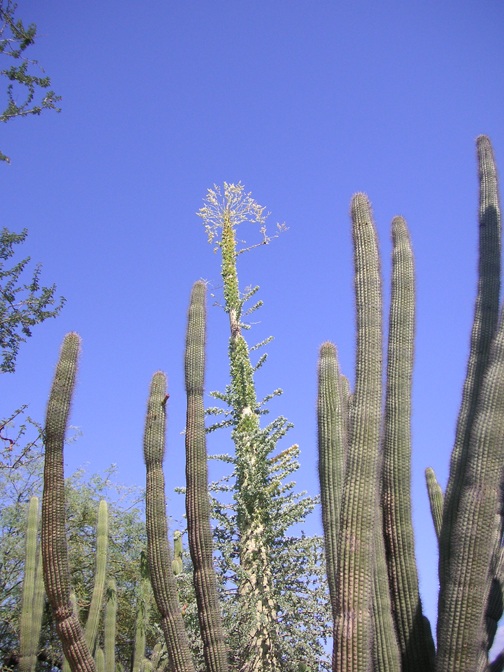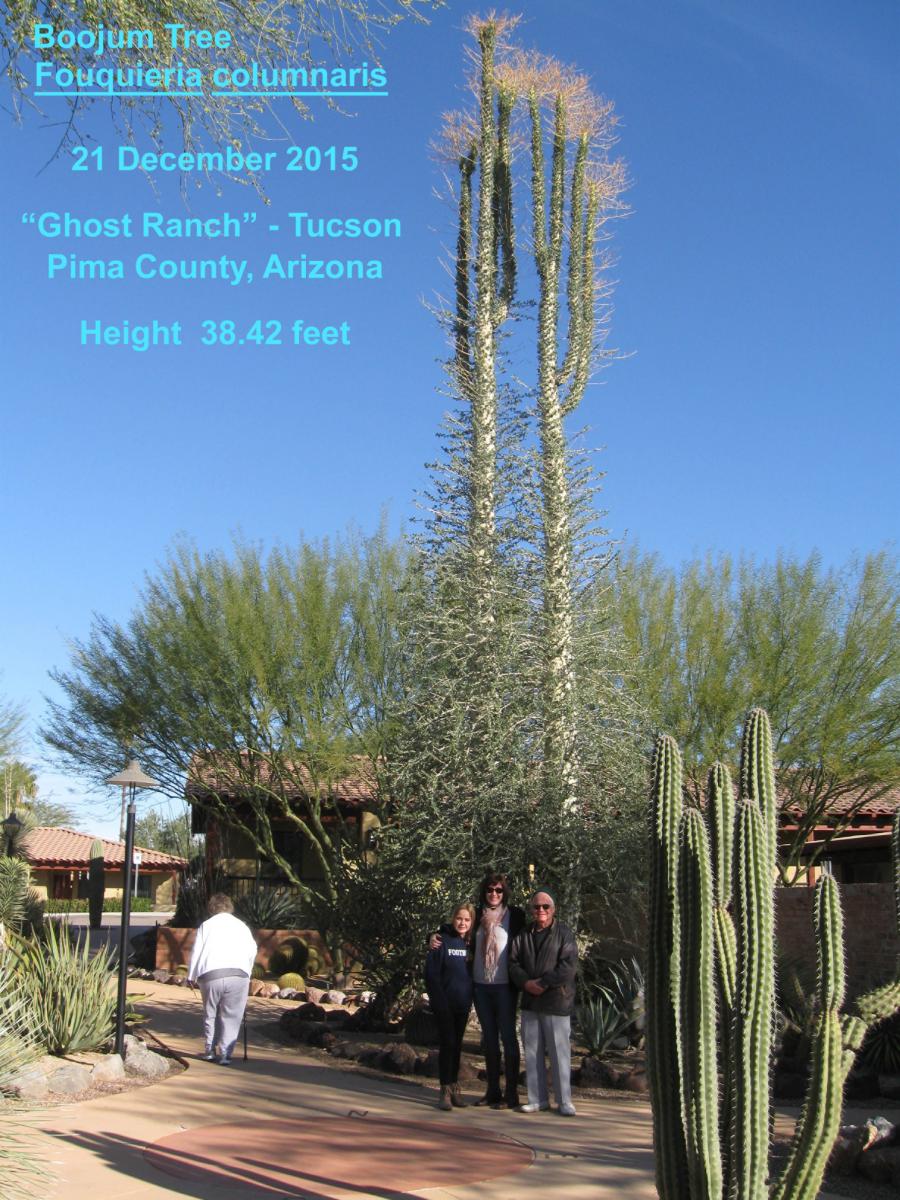Fouquieria columnaris - Boojum, Cirio
The Boojum
By Elizabeth Davison, Founding Director, UA Campus Arboretum
 The Boojum tree (Fouquieria columnaris) is one of the most bizarre-looking plants in the world. Shaped like spiny upside down carrots, they never fail to interest observers. Boojums are native to the Sonoran Desert on the west coast of Baja California, and one small area on the Sonora mainland near Puerto Libertad. Much of the information we know about their habits and ecology is described in a fascinating work by the late Dr. Robert Humphrey, "The Boojum and Its Home" (UA Press, 1974, now out of print). A member of the family Fouquieriaceae, boojums are related to Ocotillos. Their "wood" is soft and easily bruised, their epidermis is soft, and their leaves are transitory depending on water supply. In their natural habitat, rains are sporadic but coastal humidity is high. Growth occurs during cooler weather, when water (either winter rains or spring/fall fogs) is more plentiful. Although they can survive for years on little rainfall, relative humidity apparently plays a part in their successful germination and establishment. Flowers and seeds appear regularly in summer and fall.
The Boojum tree (Fouquieria columnaris) is one of the most bizarre-looking plants in the world. Shaped like spiny upside down carrots, they never fail to interest observers. Boojums are native to the Sonoran Desert on the west coast of Baja California, and one small area on the Sonora mainland near Puerto Libertad. Much of the information we know about their habits and ecology is described in a fascinating work by the late Dr. Robert Humphrey, "The Boojum and Its Home" (UA Press, 1974, now out of print). A member of the family Fouquieriaceae, boojums are related to Ocotillos. Their "wood" is soft and easily bruised, their epidermis is soft, and their leaves are transitory depending on water supply. In their natural habitat, rains are sporadic but coastal humidity is high. Growth occurs during cooler weather, when water (either winter rains or spring/fall fogs) is more plentiful. Although they can survive for years on little rainfall, relative humidity apparently plays a part in their successful germination and establishment. Flowers and seeds appear regularly in summer and fall.
University of Arizona Boojum
Historical information, gathered by three Tucson citizens: Randall Holdridge, Jim Turner, and William Thornton, reveals the interesting, more than 70 year history of the specimens in the UA Campus Krutch Garden. The same year the University of Arizona was founded, 1891, Professor James Toumey began what was to become an extensive cactus collection. Eventually comprising over 600 specimens, the garden expanded to cover a 25,000 square ft area on the western side of Old Main, the University's first building. Toumey moved on to found the School of Forestry at Yale University and by 1929, then President Homer LeRoy Shantz authorized the cactus collection to be moved to a larger area on the east side of Old Main. The 1929 cactus garden expansion was a large scale undertaking, and it could not possibly have been accomplished by the simple transplantation of the western garden. It extended east from Old Main to a line extending north from Bear Down Gym's eastern wall (roughly Vine Avenue). It was divided into three components; two long rectangles of unequal length, separated by a smaller oval component located at what was then the intersection of Highland Avenue and E. Third Street (aka, University Boulevard), by that time, as now, unquestionably a divided parkway which encompassed the full length of all three cactus garden components, and forming what is today called the Mall (Ball, 1969). Significant to this historical survey, that oval middle component coincides with, and is in fact, what is today known as the Joseph Wood Krutch Garden, the integrity of its historic footprint unchanged since the 1929 cactus garden project was completed.
Included in the expansion, several boojums, ranging in size from 1 to 8 feet or taller, were installed into the middle component of the UA cactus collection (See Shantz Photo collection showing President Shantz's 1932 photographs of 8 boojums.) Godfrey Sykes, one of the early southwestern naturalists, collected these specimens on an official expedition for the Carnegie Desert Laboratory (formally joined with the University in 1923.) Sykes was also responsible for giving the plant the English common name, "Boojum", referencing a poem by Lewis Carroll, "The Hunting of the Snark". "Cirio" is the Spanish name - meaning candle or taper. Robert Humphreys documention of growth rates of Boojum on the Baja coast indicated that some boojums on the Baja coast put on less than an inch per year, depending on weather conditions. In 2006, the three remaining University of Arizona plants were 34, 26.5, and 22 ft tall, averaging about 3" of growth per year over their 70 year history. According to Robert Humphrey, mature plants heights can reach heights of 70-80 feet, suggesting the plants on the UA campus are adolescent.
Other Boojum Facts

 Photo: Bill Thornton (left) and Bill Peachey (right) are local treasures often found botanizing about the desert, teaching, or otherwise being fascinating and likable.
Photo: Bill Thornton (left) and Bill Peachey (right) are local treasures often found botanizing about the desert, teaching, or otherwise being fascinating and likable.
William Thornton has created an inventory of Arizona's boojums. The UA's tallest plant is tied in height with one at the Ghost Ranch Lodge in Tucson. This branched specimen was measured at 33 feet tall in 2003. In 2015, William Thornton and Bill Peachy used a clinometer to measure the tree and recorded a height of 38.75 feet. They later confirmed a more precise height using a laser, of 38.43 feet. In 2019, they measured the boojum at 43.6 feet tall (see photo below) Thornton says one place to visit a large collection of boojum trees is at the San Diego Zoo's Wild Animal Park. Other specimens are at the Desert Botanical Garden in Phoenix, the Huntington Botanical Gardens and Rancho Santa Ana Botanical Gardens, both in the LA area. Now fully protected by the Mexican government, boojums are only available in the US if they've been nursery-grown. Although their selling price can be nearly $1000 per foot, in light of the recent interest, Tucson native plant nurseries have reported an increased interest in seedlings.





